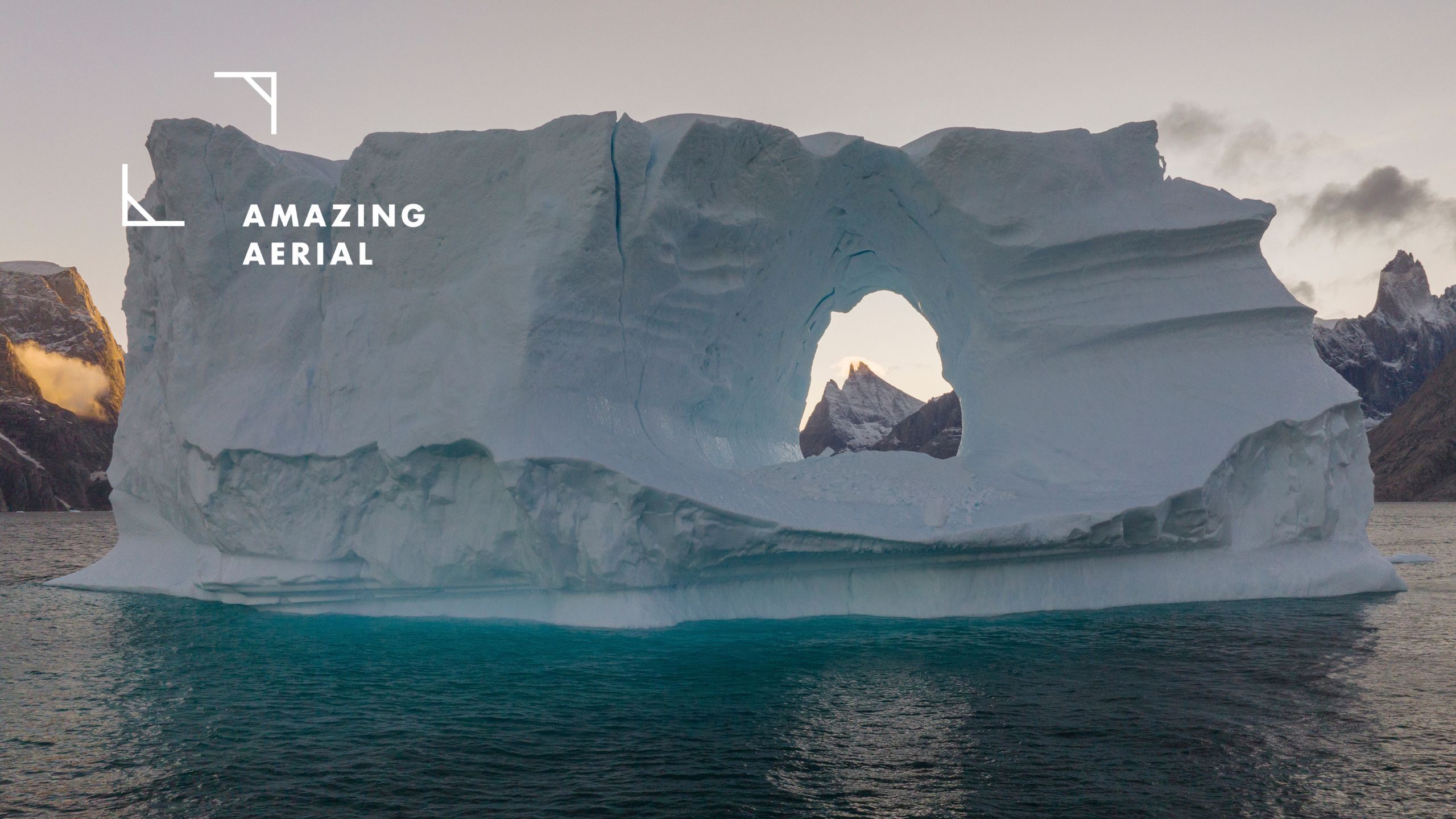Up Close and Personal with Greenland's Icebergs
Greenland’s icebergs are massive, beautiful, and due to warming sea ice, endangered. Amazing Aerial photographer Matt Borowick got close to the unpredictable ice formations on an unforgettable trip.
Oct 23, 2023

Mountains peek through a gap in a massive ice formation near the fjords of Semersooq, Greenland. Every iceberg has a different shape, shade, and ice pattern, making each one unique.. © Amazing Aerial Agency / Matthew Borowick
 By Rebecca Duras
By Rebecca Duras
Few people think about Greenland’s icebergs unless they are watching the movie Titanic. Yet, the Greenland ice sheet which they came out of will affect the future of the planet as we know it.
A recent study published in the scientific journal Nature found that Greenland’s ice sheet is melting even faster than we thought, with disastrous consequences for the world’s sea level rise. Greenland’s ice will affect so much of what life looks like on earth, yet we know so little about it.
Amazing Aerial team member Matt Borowick had a better opportunity than most non-Greenland residents to get to know the icebergs on a photo cruise. His photographs and experience show a complex ecosystem with a lot going on below the frozen surface.
Getting to Know the Frozen Colossus
“They are just on a scale that we cannot comprehend because we can’t get close enough,” Matt Borowick explains. The photographer has spent a lot of time in polar climates, most recently in Antarctica, but also in Iceland and in Greenland. While in Greenland, he spent a week on an iceberg cruise for photographers and was hooked on capturing the icy masses, drawn in by their beautiful appearance and mysterious past.
Borowick explains that what he captures in his photos and what we can see with the naked eye is a fraction of what we can know about the icebergs. For starters, 85-90% of their mass is underwater, rendering most of the iceberg invisible except to fish, seals, and cold-water scuba divers.
Icebergs are chunks of ice that break away from ice sheets and glaciers in a process called calving. They travel through the sea for months, sometimes years, sometimes decades. They get stuck—when they float into shallow water, the bottom drags into the sea floor, anchoring the iceberg in place. They get into the world’s slowest-moving traffic jams when several icebergs float into the same shallow body water.
They can even spin. When the bottom of an iceberg melts, making the iceberg top-heavy, it flips with a groaning crash. “You can see ice that hasn’t seen the light of day for years, which is also kind of crazy,” Matt explains with awe.
Icebergs are still until they are not, stationary until they are not. The unpredictability makes them hard to know because it is difficult to get close to them without risking your personal safety. Chunks of ice could fall at any time or the iceberg could flip, crushing you. The iceberg could move at any moment, so ships plot their trajectory to avoid them, especially ships that aren’t massive icebreakers. The icebergs are usually in such remote locations that your chance of hailing rescue in time is not much better than it was in the days of the ill-fated Titanic.
Matt took his photos with a drone from a safe distance away on a ship with an experienced captain, not risking getting too close to the icebergs. “It’s all part of the idea that something so simple and magical can be so dangerous. It’s close enough to be able to touch it, but you can’t touch it, because well, you might die,” Matt explains.
What Is Happening to Greenland’s Ice?
When sailing around icebergs the size of apartment buildings in Greenland, it’s hard to think of them as fragile. Yet these colossal ice beings are part of one of Earth’s most vulnerable ecosystems—and could condemn the rest of the planet for our carelessness.
In the paper in the scientific journal Nature mentioned above, a team of scientists found that Greenland’s ice sheets are melting at a faster rate than previously expected. Core ice measurements found that the sheets are the warmest they’ve been in 1,000 years. Putting the study in context for CNN, lead author Maria Horhold said that at this rate, Greenland’s melting ice sheets will cause sea levels to rise 50 centimeters by 2100.
The unscientific answer to how much water is contained in an iceberg the size of a three-story building is “a lot.” Sooner than we expected, Greenland’s now majestic icebergs might be part of the deluge that will flood coastal areas, displace millions of people, and change the world’s environment permanently.
When asked what he thought about the new study, Matt said, “I didn’t think much about it because, well, it’s not news that we’re headed in a bad direction.” On his trip to Greenland, Matt experienced the too-warm summers for himself. Greenland’s summer temperatures have started reaching up to 10 degrees Celsius when it shouldn’t be much warmer than freezing. It’s bad for local wildlife such as musk ox that are adapted to survive cold temperatures, not warm temperatures and rain. It’s bad for the ice.
What Lies Hidden Beneath the Ice
It would be a mistake to look at icebergs and just see a monolith or instruments of potential destruction—to see them as anything other than their full selves. Despite his expedition captain jokingly warning that he would be bored of icebergs in a few days, Matt spent the whole week capturing photo after photo of Greenland’s impressive icebergs.
“You can focus on literally any part of it—the details, the scale, the colors…” Matt trails off describing the many photos that he took during his time in Greenland. Icebergs change color according to the weather, ranging from bright white in sunny weather to deep blues and greens when it gets cloudy. With a good lens, you can capture the ridging in the ice, which is unique to each iceberg (our photographer Julia Pertek made the same observation about glacial ice in Iceland).
With a drone, Matt sometimes captured icebergs streaked with black and brown. These streaks are sediment remnants that were in the glacier the iceberg broke off from. It could tell us where the iceberg came from—but of course, one would have to get close enough to gather the sample.
It’s also a mistake to think of icebergs as lifeless ice. Some icebergs contain microorganisms such as phytoplankton. They provide a resting place for migrating birds. As they melt, they create a nutrient-rich soup that is a perfect breeding ground for phytoplankton, in turn feeding fish and other animals.
As Matt’s photos show us, even with the little that we know about them, there are many ways to look at icebergs. The trick is changing the world so that we still have something to look at in the future.
Stay updated when we post new articles.
We hate SPAM. We will never sell your information, for any reason.










